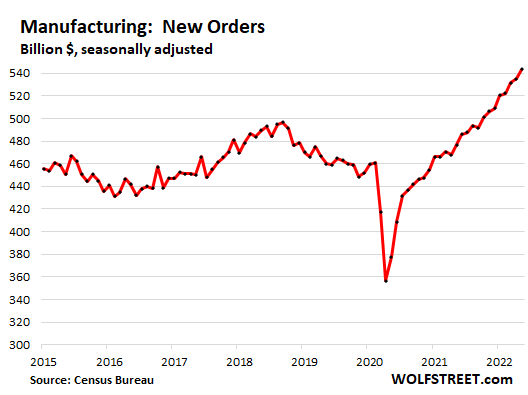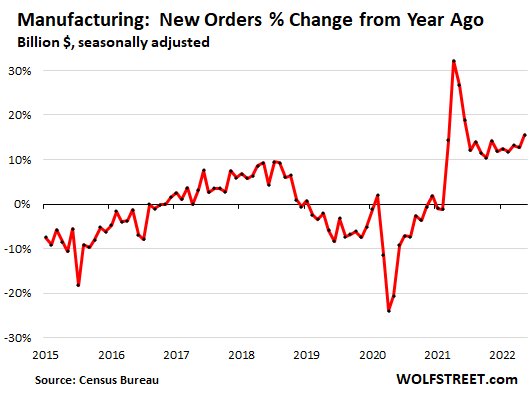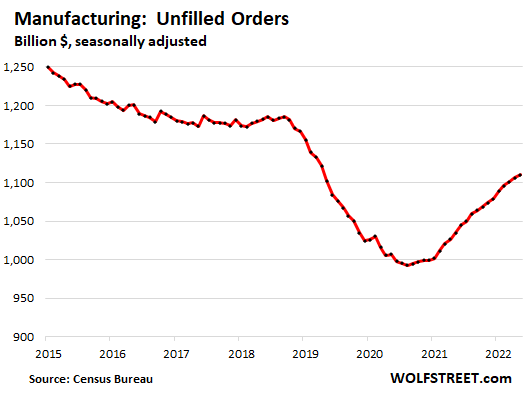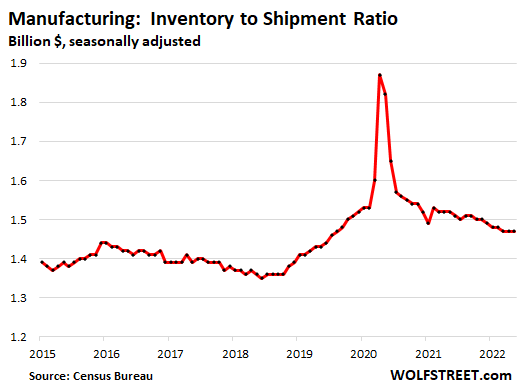ipopba/iStock via Getty Images
Consumers shift their spending back to services. The spending boom on goods is over, and it will eventually show up in manufacturing.
Manufacturing in the US, as measured by new orders received, ramped up further in May, with raging inflation being part but not all of the equation, and unfilled orders ticked up further, and the key inventory ratio of inventories-to-shipments – which eliminates the effects of inflation – held at the lowest levels since August 2019.
The impact of the rate hikes or any slowdown is not yet visible in the manufacturing data for May. But surveys of executives conducted in June and released last week as the Manufacturing PMIs hint at a first dip in orders in June from the fairly strong May.
New orders for manufactured goods in May rose by 1.6% from April, seasonally adjusted, to $543 billion, according to data from the Census Bureau today: orders for manufactured durable goods +0.8% to $267 billion; orders for manufactured nondurable goods +2.3% to $276 billion.

On a year-over-year basis, new orders for manufactured goods jumped by 14% in May, after a series of massive year-over-year increases for the past two years, with orders for manufactured durable goods increasing by 12.2%, and for manufactured nondurable goods by 18.9%.

Durable goods manufacturing.
Transportation equipment is the largest category of durable goods, with $82.8 billion in orders in May, not seasonally adjusted, up by 19.7% from a year ago. The vast majority of this sector is composed of cars and trucks, heavy trucks, buses, components, and trailers, which account for almost 70% of the sector. Aircraft (nondefense and defense combined) account for 18% of the total transportation orders. Ships and boats account for 3% of transportation orders.
| Largest categories of durable goods, not seasonally adjusted | billion $ in May | % change yoy |
| Transportation equipment (autos, heavy trucks, components, trailers, aircraft, ships and boats) | 82.8 | 19.7% |
| Fabricated metal products | 38.6 | 9.8% |
| Machinery | 38.2 | 11.6% |
| Computers and electronic products | 22.2 | 4.8% |
| Primary metals | 21.9 | 14.9% |
| Electrical equipment, appliances, components | 13.4 | 7.1% |
Unfilled orders rose to $1.11 trillion in May, up by 7.3% from a year ago. All of this year-over-year increase is likely accounted for by price increases:

Inventory levels in dollar terms are inflated by cost increases, and are not indicative of whether or not inventories are piling up – the rumored “inventory glut.” But the inventory-to-shipment ratio eliminates the factor of prices and price increases, and in May, the ratio remained unchanged from April at 1.47, the lowest since August 2019, according to the Census Bureau:

The impact of the rate hikes or any slowdown in demand is not yet visible in the manufacturing data for May.
But there are the surveys of manufacturing executives for June: Though the overall ISM Manufacturing PMI for June was in growth mode, the new orders index within it dipped to 49.2, from the fairly strong reading in May (55.1), with 50 being the dividing line between rising and falling orders on a month-to-month basis.
Spending is shifting from goods back to services. For months now, consumers have shifted from the mind-boggling pandemic-related spending boom on goods back to spending on services. Spending on discretionary services had collapsed during the pandemic, and it has been coming back, even as spending on goods dropped. Consumer spending on services accounts for over 60% of total consumer spending. And this shift is huge – even adjusted for inflation. Read… Consumer Spending Shifting Back to Services from Stimulus-Binge on Goods. Inflation Eats into Incomes
Editor’s Note: The summary bullets for this article were chosen by Seeking Alpha editors.


Be the first to comment